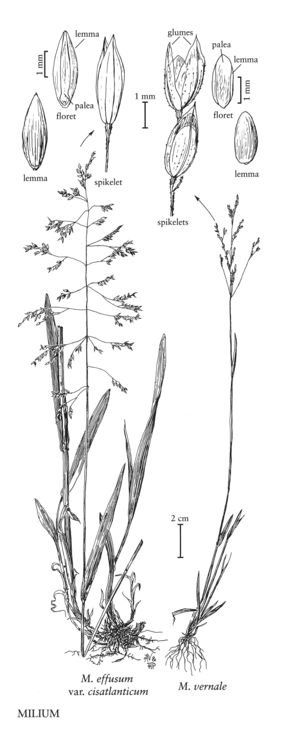| Taxon | Illustrator ⠉ | |
|---|---|---|
 | Milium effusum Milium vernale | Linda Ann Vorobik Hana Pazdírková Linda Ann Vorobik Hana Pazdírková |
Plants annual or perennial; cespitose, sometimes rhizomatous. Culms 10-180 cm, glabrous or hispidulous; nodes 2-5, glabrous. Sheaths open, smooth or scabrous; auricles absent; ligules hyaline, glabrous, obtuse to acute; blades flat, smooth or scabrous over the veins. Inflorescences open panicles; branches drooping to ascending, smooth or scabrous, some branches longer than 1 cm. Spikelets pedicellate, dorsally compressed, with 1 floret; rachillas not prolonged beyond the base of the floret; disarticulation above the glumes, beneath the floret. Glumes equal, equaling or exceeding the lemmas, membranous, smooth or scabrous, unawned; calluses blunt, glabrous; lemmas dark, coriaceous, glabrous, lustrous, obscurely 5-veined, margins involute, apices unawned; paleas similar to the lemmas and partly enfolded by them; lodicules 2, free, glabrous, toothed or not; anthers 3; ovaries glabrous. Caryopses shorter than the lemmas, concealed at maturity, glabrous; hila 1/5 to nearly 1/2 the length of the caryopses. x = 4, 5,7,9.
Distribution
Wis., W.Va., N.H., N.J., N.C., Tenn., N.Y., Pa., Va., Conn., Iowa, Ill., Ind., Mass., Md., Maine, Mich., Minn., Ohio, S.Dak., Vt., Idaho, Man., N.B., Nfld. and Labr., N.S., Ont., Que., Sask.
Discussion
Milium is a circumtemperate genus of four species. All the species grow in mesic to dry mixed woods and dry open habitats. Milium effusum is native to the Flora region; M. vernale has become established.
Selected References
Lower Taxa
Key
| 1 | Plants perennial; blades 8-17 mm wide; panicles 10-27 cm long; lemmas 2.3-3 mm long | Milium effusum |
| 1 | Plants annual; blades 1.9-5 mm wide; panicles 4-11.5 cm long; lemmas 2-2.3 mm long | Milium vernale |
"decumbent" is not a number.